What Do We Mean by Geometry in Daily Life?
In our everyday lives, we observe a variety of shapes, patterns, and colors. Whether we’re shopping for clothes, browsing books, or selecting accessories, our choices often reflect an appreciation for captivating designs. Geometry plays a crucial role in understanding and appreciating these elements.
Dating back to 3000 BC, the origins of geometry can be traced to ancient Egypt. Mathematicians of that era employed geometry to develop formulas and calculate the areas of objects, even those with irregular shapes and internal angles. Through geometry, they unlocked the secrets of construction, architecture, and design.
While this article won’t magically make learning geometry easier, it aims to ignite your curiosity about this captivating subject. By exploring the wonders of geometry in real-life contexts, we can deepen our appreciation for the patterns, shapes, and structures that surround us every day.
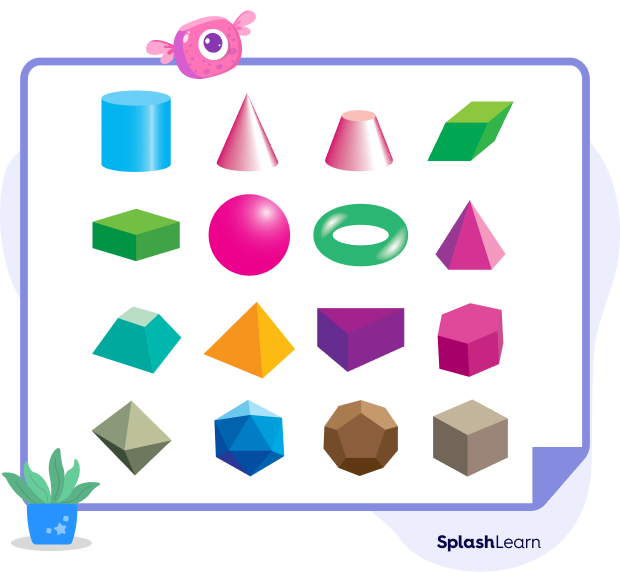
Recommended Games
What Is Geometry?
Geometry is a branch of mathematics that focuses on the study of shapes, sizes, properties, and dimensions of objects and spaces. It explores the relationships and patterns that exist in the physical world, using precise mathematical methods. Euclid is considered to be the “Father of Geometry.”
Geometry is concerned with the properties of points, lines, angles, surfaces, and solids, and it plays a fundamental role in various fields, including architecture, engineering, physics, art, and computer science.
Whether it’s a man made construction or an organic lifeform, geometric shapes have helped to shape the world around us. With that in mind, let’s take a brief look at what geometry is used for how geometry has impacted the world we live in.
Recommended Worksheets
What Is Geometry Important?
Geometry is crucial because it helps us understand and describe the fundamental properties of the physical world, enabling us to solve real-world problems, design structures, and advance various fields, including science, engineering, and art.
Geometry has played a fundamental role in shaping the world we live in. From man-made structures to living organisms, geometric shapes have left their mark. Let’s explore how geometry is utilized and its impact on our lives.
Practical Applications of Geometry in Daily Life
Let’s talk about some significant examples of geometry in the real world that consistently have a major impact on people’s daily lives.
Practical Applications of Geometry in Nature:
The natural world is a great example of geometry’s practical applications in everyday life. By taking a closer look at our surroundings, we can observe an abundance of geometrical patterns and shapes.
Here are some examples that demonstrate the presence of geometry in nature, showcasing its beauty, efficiency, and the underlying mathematical principles that govern the natural world.
| Example | Image |
|---|---|
| Honeycomb: The structure of a honeycomb is made up of hexagonal cells, which is an optimal shape for storing honey and maximizing space efficiency |  |
| Snowflakes: Snowflakes exhibit intricate, symmetrical patterns due to the geometric arrangement of water molecules as they freeze. |  |
| Sunflowers: The seeds of a sunflower are arranged in a pattern known as the Fibonacci spiral, which follows a geometric sequence and provides an optimal arrangement for maximizing seed distribution. |  |
| Spider Webs: Spider webs often showcase intricate geometric patterns formed by radial lines and concentric circles, enabling spiders to capture prey effectively. |  |
- Practical Applications of Geometry in Computer graphics:
Geometry is an integral part of computer graphics, used to create visually stunning images and animations. It involves defining shapes, objects, and characters, as well as applying transformations for movement and interaction. Through rendering techniques, geometry helps simulate realistic lighting, shadows, and reflections. It also plays a role in 3D modeling and the creation of special effects like explosions and water simulations. In virtual reality and augmented reality, geometry is essential for constructing immersive virtual environments. Overall, geometry empowers computer graphics artists to bring their imaginations to life on screens, enriching our visual experiences.

- Practical Applications of Geometry in Architecture:
Building and monument architecture is solely based on geometrical applications. It is believed that during ancient times, geometry was primarily developed for use in building dwellings and other structures.
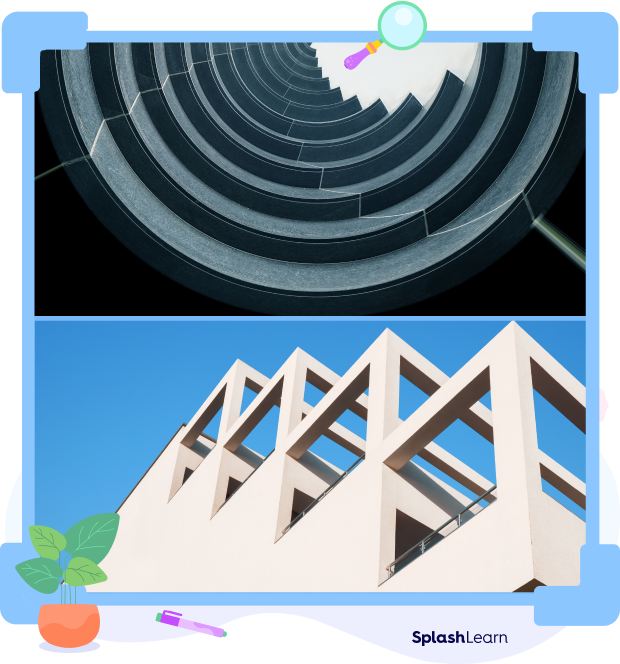
- Practical Applications of Geometry in Art:
Geometry and art have an intertwined relationship, with geometric principles serving as a powerful tool for artists to express their creativity, establish order, and evoke emotions. By harnessing the potential of geometry, artists create visually captivating works that resonate with viewers.
Geometry in art has practical applications. Artists use geometric principles in composition, perspective, and proportions to create visually pleasing artworks. Symmetry, patterns, and geometric shapes are incorporated into art pieces. Geometry influences sculpture, architecture, optical illusions, and kinetic art. In digital art, geometry provides structure and visual harmony. These practical applications enhance artistic expression, resulting in captivating and visually engaging works.
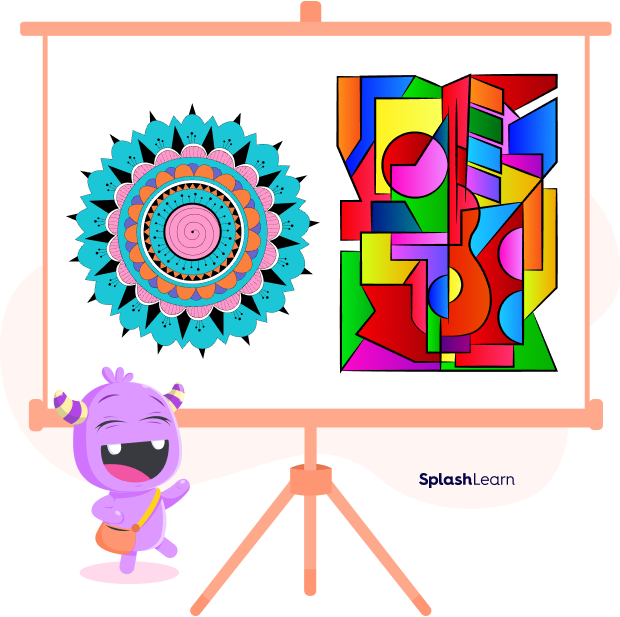
- Practical Applications of Geometry in Interior Designing:
Geometry finds practical applications in interior design, bringing aesthetic appeal and a sense of harmony to living spaces. By incorporating geometric patterns in wallpaper or flooring, rooms can appear taller or more spacious due to the continuous flow of the patterns.
Even in the smallest details, geometry plays a role. Objects like hexagonal door knobs or cushions with hexagonal patterns add an intriguing touch. By integrating geometric elements throughout the room in a cohesive manner, the eye is drawn around the space, allowing for an appreciation of the harmonious interplay of shapes and lines.
Geometry in interior design enhances visual interest, adds a modern touch, and contributes to a sense of balance and cohesion within the overall design scheme.

- Practical Applications of Geometry in Sports:
Geometry plays a practical role in various sports by defining and marking out specific areas of play.
Let’s take a closer look at the soccer pitch as an example. The field of play is composed of geometric shapes like quadrilaterals and rectangles, with 90-degree angles forming the corners. Additionally, the center circle acts as a key component for starting the game. These geometric elements provide structure, boundaries, and strategic guidelines for players to navigate and compete within the sport.
Geometry in sports ensures fair play, facilitates gameplay strategies, and contributes to the overall excitement and organization of the game.
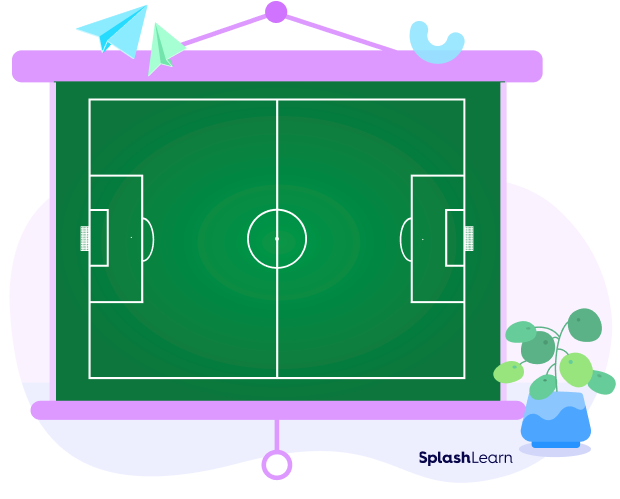
Geometric Shapes in Daily Life
Geometric shapes are prevalent in our everyday lives, appearing in various objects and structures. Here are some examples of geometric shapes in real life, tailored to a US audience:
- Traffic signs: Stop signs, yield signs, and speed limit signs often feature octagonal, triangular, and rectangular shapes.
- Buildings: Skyscrapers, houses, and architectural structures incorporate geometric shapes such as squares, rectangles, triangles, and circles in their design.
- Sports fields: Soccer fields, basketball courts, and baseball diamonds showcase rectangles, circles, and various lines to delineate playing areas.
- Packaging: Boxes, cans, and containers commonly have rectangular or cubic shapes for practical storage and transportation.
- Road markings: Lane dividers, crosswalks, and parking spaces utilize lines and rectangles to guide traffic and ensure safety.
- Furniture: Tables, chairs, and bookshelves often feature rectangular, square, or circular shapes in their design.
- Technology: Computer screens, mobile phones, and tablets typically have rectangular or square shapes for practical display purposes.
- Nature: Honeycombs, snowflakes, and sunflower seeds display intricate geometric patterns and shapes found in the natural world.
- Art: Paintings, sculptures, and pottery incorporate geometric shapes and patterns to create visually appealing and balanced compositions.
- Jewelry: Rings, pendants, and earrings can feature geometric shapes like circles, squares, or triangles in their design.
These examples demonstrate how geometric shapes are found in various aspects of our daily lives, highlighting their practical applications and aesthetic appeal.

Uses of Geometry in Daily Life
Geometry finds numerous practical applications in our daily lives, influencing various contexts and enhancing our understanding of the world around us.
Where do we see the application of Geometry in our daily life? Here are some uses of geometry in real life:
Construction and Architecture: Geometry guides builders and architects in designing structures with proper dimensions, angles, and stability.
Interior Design: Geometry helps plan furniture layout, determine proportions, and create visually appealing arrangements.
Navigation: Geometry assists in map reading, understanding distances, angles, and calculating routes for travel.
Art and Design: Geometry plays a role in creating visually balanced compositions, patterns, and sculptures.
- Cooking and Baking: Geometry is applied when measuring ingredients, cutting food into shapes, and arranging presentations.
- DIY Projects: Geometry is essential for accurate measurements, cutting angles, and assembling components in home improvement tasks.
- Fashion and Textiles: Geometry influences patterns, fabric design, and garment construction, ensuring proper fit and aesthetics.
- Financial Planning: Geometry helps with budgeting, calculating areas and volumes, and understanding interest and investments.
- Sports and Gaming: Geometry is used in sports fields, game strategies, angles of shots, and determining winning positions.
- Technology and Digital Media: Geometry is applied in graphic design, video game development, and computer-generated imagery.
- Environmental Planning: Geometry aids in understanding land surveying, urban planning, and conservation efforts.
These everyday applications of geometry demonstrate its relevance and impact on various aspects of our lives, showcasing its practicality and importance in multiple contexts.
Facts on Geometry in Daily Life
- Geometry studies the size, shapes, and positions of objects.
- The concept of golden ratio (approximately 1.618) was used by the Greeks in art and architecture.
- Knowledge of geometry is vital for computer graphics and solving structural problems.
- The Great Pyramid showcases the wonders achieved through geometry.
- Geometry is used in architecture, interior design, and construction for stable and visually appealing structures.
- Navigation, maps, and route planning rely on geometry to calculate distances and plan efficient paths.
- Artists and designers apply geometric shapes and patterns for visual harmony in their works.
- Everyday activities like cooking, sewing, and DIY projects involve geometry for measurements and precision.
- Sports strategies, field layouts, and shot angles utilize geometry for optimal performance.
Solved Examples on Geometry in Daily Life
Example 1: Which geometric shapes do you see in the image given below ?

Solution:
The geometric shapes in the image are as follows:
1.The sun is made up of a circle and triangles
2.The house is made up of triangles, trapezium, rectangles, squares, and semicircles.
3. The mailbox is made up of a pentagon, circle, and rectangles.
4. The flowers are made up of lines, circles and semicircles.
5. The grass is shown in the shape of a semicircle.
Example 2: Give some examples of square shaped objects around you.
Solution:
Common examples of this shape include a chessboard, craft papers, bread slice, photo frame, pizza box, a wall clock, etc.
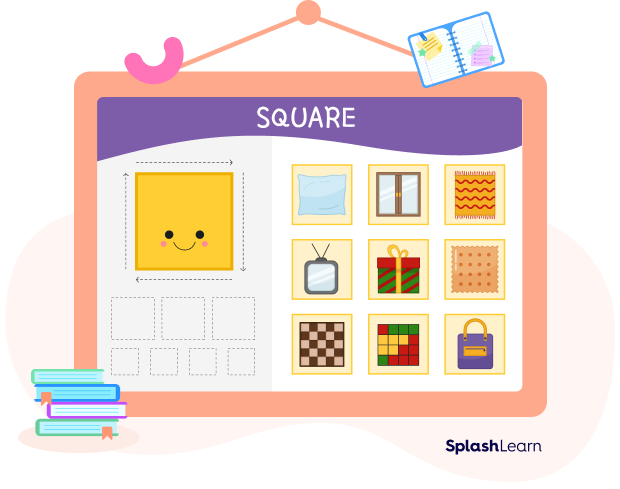
Example 3: Match the object with its shape.
| Object | Shape |
|---|---|
| Brick | i) Sphere |
| Ball | ii) Cone |
| Food can | iii) Cuboid |
| Party hat | iv) Cylinder |
Solution:
(a) Brick – (iii) Cuboid
(b) Ball – (i) Sphere
(c) Food can – (iv) Cylinder
(d) Party hat – (ii) Cone
Practice Problems on Geometry in Daily Life
Geometry in Daily Life - Definition, Applications, Uses, Examples
Which geometric shape do you see in the honeycomb?
The image given above is a beehive. All cells inside a beehive are in the shape of a six-sided hexagon. It's a phenomenal example of geometry in daily life !
What shape of geometry is this real life image?

A tuna can has the shape of a cylinder.
The shape of the soccer ball is a _______. The black geometric shape on it is a ____.

Soccer ball has a spherical shape. The black colored patch is a pentagon.
Frequently Asked Questions about Geometry in Daily Life
What are the applications of geometry in real life?
- Geometry enhances analytical, logical, and problem-solving skills, supporting holistic development.
- It helps learners connect classroom concepts to real-world situations, fostering practical thinking.
- Geometric shapes and sizes in toys aid cognitive development during early childhood.
Is there geometry in astronomy?
Astronauts use math for precise calculations in space missions, from spacecraft launch to piloting. Designers apply geometry to ensure safety and calculate distance, speed, and velocity of space vehicles. Geometry aids in measuring distances of stars in astronomy and is utilized in satellite navigation systems.
Why is geometry important in daily life?
Geometry is important in daily life because it helps with spatial understanding, measurements, and problem-solving. It enables us to navigate our surroundings, plan and design spaces, and make accurate calculations for various practical tasks.
Where do we see the application of geometry in our daily life?
Geometry is extensively used in various fields such as art, technology, science, medicine, sports, robotics, and space. It is essential for computer-aided design, industrial assembly system design, nanotechnology, computer graphics, video game programming, and more real-world applications.
What are some examples of geometric principles applied in art and design?
Geometric principles are commonly applied in art and design. Artists use symmetry, proportion, and geometric shapes to create visually appealing compositions. Geometric patterns and tessellations are seen in various art forms, architecture, and decorative elements.
How does geometry play a role in sports?
Geometry plays a role in sports in various ways. Athletes and coaches use geometric principles to analyze angles and trajectories in activities like throwing, kicking, and shooting. Sports venues and fields are designed using geometric layouts for optimal performance and spectator experience.
What is an example of geometric rays in real life?
Sun rays are excellent examples of geometric rays in real life. Sunlight consists of rays of light that travel in straight lines from the Sun to Earth.



























